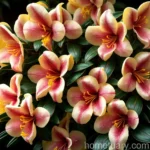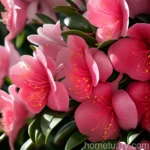Evergreen Azalea (Rhododendron ‘Hershey’s Red’) Care Guide
As a plant scientist specializing in horticulture and plant care, I am excited to share my knowledge and expertise on caring for the evergreen azalea, specifically the Rhododendron ‘Hershey’s Red’ variety. In this comprehensive guide, you will learn about the cultural aspects, uses, maintenance, and common issues associated with this beautiful evergreen azalea. Whether you are a seasoned gardener or a beginner looking to add these stunning plants to your landscape, this guide will provide you with valuable insights and practical tips for successful cultivation.
What is an Evergreen Azalea (Rhododendron ‘Hershey’s Red’)?
The evergreen azalea, scientifically known as Rhododendron, is a popular and exquisite flowering shrub that belongs to the Ericaceae family. It is renowned for its vibrant and showy blooms, making it a favorite choice for gardens, landscapes, and ornamental displays. Specifically, the Rhododendron ‘Hershey’s Red’ variety is prized for its striking crimson-red flowers and its evergreen foliage, which adds visual interest throughout the year.
Native to Asia and North America, the evergreen azalea thrives in temperate climates and is cherished for its ability to enhance the beauty of outdoor spaces with its abundant flowers and lush greenery. With the right care and attention to its specific needs, this plant can become a standout feature in any garden, providing an array of colors and textures that are sure to captivate any onlooker.
Key Takeaways – Evergreen Azalea (Rhododendron ‘Hershey’s Red’)
Before delving into the specifics of caring for the Rhododendron ‘Hershey’s Red’, it’s essential to highlight some key takeaways that will serve as a foundational understanding of this remarkable plant.
- Botanical Name: Rhododendron ‘Hershey’s Red’
- Plant Type: Evergreen Azalea
- Foliage: Evergreen
- Flower Color: Crimson-red
- Growth Habit: Compact and Bushy
- Hardiness: USDA zones 6-9
- Soil pH: Acidic (5.0-6.0)
- Sunlight: Partial to Full Shade
- Mature Height: 3-4 feet
- Uses: Borders, Mass Plantings, Containers
- Disease Resistance: Moderately resistant
- Pest Susceptibility: Minimal
Now, let’s explore the various aspects of caring for the Rhododendron ‘Hershey’s Red’ in detail, covering culture, water, sunlight, fertilizer, soil, pruning, propagation, and container gardening.
Culture
Cultivating the Rhododendron ‘Hershey’s Red’ successfully begins with understanding its cultural requirements, including the ideal growing conditions, planting guidelines, and general maintenance practices.
Planting
- Planting Time: Early spring or fall
- Location: Partial shade with protection from harsh afternoon sun
- Soil Preparation: Well-draining, acidic soil enriched with organic matter
- Spacing: 2-3 feet apart for optimal air circulation
- Mulching: Apply a 2-4 inch layer of organic mulch to maintain soil moisture and temperature
Water
Proper watering is crucial for the health and vitality of the Rhododendron ‘Hershey’s Red’, especially during its establishment phase and periods of drought.
- Watering Frequency: Regular deep watering, especially during dry spells
- Avoid Overhead Watering: Direct water to the base of the plant to prevent foliage diseases
- Moisture Monitoring: Check soil moisture regularly to ensure consistent hydration
- Winter Moisture: Ensure adequate soil moisture during winter to prevent desiccation
Sunlight
While the evergreen azalea thrives in partial shade, providing the right balance of sunlight is essential for promoting healthy growth and abundant flowering.
- Ideal Sun Exposure: Partial shade with filtered sunlight
- Morning Sun: Preferable over harsh afternoon sun
- Protection from Hot Afternoon Sun: Shield from intense sunlight to prevent leaf scorch
Fertilizer
Applying the appropriate nutrients at the right time is vital for enhancing the Rhododendron ‘Hershey’s Red’s growth, flowering, and overall vigor.
- Fertilizer Type: Use a balanced, acidic fertilizer formulated for azaleas and rhododendrons
- Application Time: Apply fertilizer in early spring before new growth emerges
- Avoid Excessive Nitrogen: Limit nitrogen to prevent excessive vegetative growth at the expense of flowering
- Foliar Feeding: Use a water-soluble fertilizer for foliar application if signs of nutrient deficiencies are observed
Soil
The soil composition and pH level profoundly impact the success of evergreen azaleas, making it crucial to provide an optimal growing medium for the Rhododendron ‘Hershey’s Red’.
- Soil Type: Well-draining, organic-rich soil with high acidity
- pH Requirements: Acidic soil with a pH range of 5.0-6.0
- Organic Matter: Enrich soil with compost, peat moss, or pine bark to improve texture and acidity
- Soil Moisture: Maintain consistent soil moisture without waterlogging
Pruning
Pruning is an essential aspect of maintaining the Rhododendron ‘Hershey’s Red’s shape, controlling its size, and promoting vigorous growth and prolific flowering.
- Pruning Time: After flowering but before new buds set for the following year
- Deadheading: Remove spent flowers to encourage new bud formation
- Thinning: Prune crowded or crossing branches to improve air circulation and light penetration
- Rejuvenation Pruning: Renew overgrown or leggy plants by selectively removing older stems
Propagation
Expanding your collection of evergreen azaleas or sharing these beautiful plants with others can be achieved through successful propagation methods.
- Propagation Techniques: Stem cuttings, layering, and grafting
- Timing: Propagate in early summer when new growth is semi-hardened
- Rooting Hormone: Use a rooting hormone to enhance the success of stem cuttings
- Bottom Heat: Provide gentle bottom heat to accelerate rooting of stem cuttings
Container Gardening
The versatile nature of the evergreen azalea makes it well-suited for container gardening, allowing for flexibility in placement and maintenance.
- Container Selection: Choose a well-draining container slightly larger than the root ball
- Potting Mix: Use an acidic potting mix designed for azaleas and rhododendrons
- Drainage: Ensure adequate drainage holes at the bottom of the container
- Regular Monitoring: Assess soil moisture and water as needed to prevent drought stress
Uses
The Rhododendron ‘Hershey’s Red’ offers various uses in landscaping and garden designs, showcasing its beauty and versatility in outdoor spaces.
- Borders and Edging: Create stunning borders and edges with its compact growth habit
- Mass Plantings: Showcase a vibrant display of color and form through mass plantings
- Containers: Accentuate patios, decks, and entryways with container-grown specimens
- Woodland Gardens: Thrive in shaded woodland settings with well-draining soil
Common Diseases
Despite its overall resilience, evergreen azaleas are susceptible to certain diseases that require vigilant monitoring and preventive measures.
Disease Prevention
- Proper Air Circulation: Maintain adequate spacing between plants to reduce humidity around foliage
- Avoid Overhead Watering: Minimize moisture on foliage to prevent fungal diseases
- Regular Inspections: Monitor for signs of leaf spot, powdery mildew, and petal blight
- Prompt Removal: Remove and dispose of diseased plant material to prevent spread
Disease Resistance
The Rhododendron ‘Hershey’s Red’ exhibits moderate resistance to common azalea diseases, particularly if provided with optimal growing conditions and attentive care.
Common Pests
Several pests pose potential threats to the health and vigor of evergreen azaleas, warranting proactive measures for pest management.
Pest Monitoring
- Regular Inspection: Check for aphids, lace bugs, and spider mites on foliage and stems
- Underside Examination: Inspect the undersides of leaves for signs of pests and eggs
- Early Intervention: Address pest infestations promptly to prevent population explosion
Botanist’s Tips
As a botanist, here are some pro tips to enhance the success of growing and caring for the Rhododendron ‘Hershey’s Red’:
- Seasonal Monitoring: Regularly observe plant health and growth throughout the seasons
- Customized Care: Adjust care practices based on the unique needs of your specific growing environment
- Soil Testing: Periodically assess soil pH to maintain optimal acidity levels
- Observation Skills: Pay attention to subtle changes in foliage color and texture to detect early signs of stress or deficiency
Fun Facts
To appreciate the evergreen azalea even further, here are some intriguing and delightful facts about this remarkable plant:
- The name “Rhododendron” is derived from the Greek words “rodon” and “dendron,” translating to “rose tree,” alluding to its abundant and colorful blooms.
- Evergreen azaleas are known to attract pollinators such as bees, butterflies, and hummingbirds, contributing to the biodiversity of garden ecosystems.
- The Rhododendron ‘Hershey’s Red’ is magnificent when showcased in combination with other spring-flowering plants, creating breathtaking seasonal displays.
Links to External Resources
For further information and resources on evergreen azalea care, varieties, and cultivation, consider exploring the following reputable sources:
- American Rhododendron Society: https://www.rhododendron.org/
- Royal Horticultural Society (RHS): https://www.rhs.org.uk
- The Azalea Society of America: https://www.azaleas.org/
In conclusion, the evergreen azalea, particularly the captivating Rhododendron ‘Hershey’s Red’, embodies an exquisite blend of beauty, resilience, and ornamental value that enriches outdoor spaces with its vibrant presence. By embracing the insights and recommendations outlined in this care guide, you can embark on a fulfilling journey of nurturing and showcasing the timeless allure of this beloved flowering shrub.
Remember, successful cultivation of the Rhododendron ‘Hershey’s Red’ entails a harmonious balance of attentive care, understanding of its unique requirements, and an appreciation for its remarkable aesthetic and ecological contributions. Happy gardening!
Keywords: Rhododendron ‘Hershey’s Red’ care, Evergreen azalea varieties, Rhododendron ‘Hershey’s Red’ pruning tips, How to grow evergreen azaleas, Rhododendron ‘Hershey’s Red’ planting guide, Evergreen azalea maintenance, Rhododendron ‘Hershey’s Red’ growth habits, Tips for growing Rhododendron ‘Hershey’s Red’, Evergreen azalea landscape ideas, Rhododendron ‘Hershey’s Red’ disease prevention, Rhododendron ‘Hershey’s Red’ hardiness, Best soil for evergreen azaleas, Rhododendron ‘Hershey’s Red’ watering needs, Evergreen azalea propagation techniques, Rhododendron ‘Hershey’s Red’ container gardening, Rhododendron ‘Hershey’s Red’ companion plants, Evergreen azalea bloom time, Rhododendron ‘Hershey’s Red’ sunlight requirements, How to overwinter evergreen azaleas, Rhododendron ‘Hershey’s Red’ fertilization tips, Pruning techniques for evergreen azaleas, Rhododendron ‘Hershey’s Red’ pests and diseases, Evergreen azalea landscaping tips, Rhododendron ‘Hershey’s Red’ winter care, Rhododendron ‘Hershey’s Red’ shade tolerance, Evergreen azalea growth rate, Rhododendron ‘Hershey’s Red’ soil pH requirements, Ideal climate for evergreen azaleas, Rhododendron ‘Hershey’s Red’ container care, Evergreen azalea pruning schedule, Rhododendron ‘Hershey’s Red’ mulching techniques, Evergreen azalea pollination methods, Rhododendron ‘Hershey’s Red’ foliage characteristics, Best fertilizer for evergreen azaleas, Rhododendron ‘Hershey’s Red’ companion shrubs, Evergreen azalea transplanting tips, Rhododendron ‘Hershey’s Red’ water drainage requirements, Tips for successful evergreen azalea cultivation, Rhododendron ‘Hershey’s Red’ disease resistance, Evergreen azalea container gardening ideas, Rhododendron ‘Hershey’s Red’ seasonal maintenance, Evergreen azalea winter protection, Rhododendron ‘Hershey’s Red’ soil preparation, Evergreen azalea pruning techniques, Rhododendron ‘Hershey’s Red’ humidity tolerance, Evergreen azalea root system, Rhododendron ‘Hershey’s Red’ blooming period, Evergreen azalea variety comparison, Rhododendron ‘Hershey’s Red’ sun exposure, Pruning tools for evergreen azaleas*















